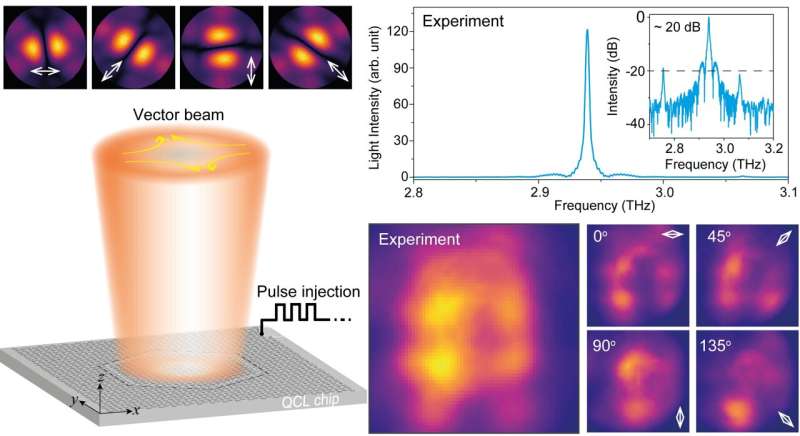This article has been reviewed according to Science X's editorial process and policies. Editors have highlighted the following attributes while ensuring the content's credibility:
fact-checked
peer-reviewed publication
trusted source
proofread
Topological bulk BICs enable compact, single-mode and beam-engineered QCLs

Electrically pumped semiconductor lasers are among the most important sources, owing to their high efficiency, compactness, and solid-state stability. For mid-infrared and terahertz radiation, quantum cascade lasers (QCLs) are the most important light sources operating via electrical pumping. To demonstrate single-mode laser emission, artificially designed distributed-feedback (DFB) gratings can be patterned on top of a ridge laser.
Such DFB-based QCLs can give rise to near Watt-level output emission while maintaining single-mode emission. However, in addition to single-mode operation, research on QCLs still requires non-trivial beam engineering (e.g., circular polarized beams, vortex beams, and other vector beams) and high optical emission from a single laser device, which is highly desired for advanced optoelectronic applications, such as communications, imaging, spectroscopy, and so on.
In a new paper published in Light Science & Application, a team of scientists led by Professor Qi Jie Wang from School of Electrical and Electronic Engineering, Nanyang Technological University, Singapore, has developed an electrically-pumped compact topological bulk laser that simultaneously offers single-mode emission and a cylindrical vector beam over the full dynamic range.
"The development of electrically pumped topological insulator lasers has drawn a lot of research interests recently because it is considered as one promising direction with great prospects in pushing the boundaries of topological photonics into practical applications. Photonic topology stems from condensed matter physics. By properly constructing a topological photonic cavity and integrating it with gain materials, we can make it lase," the researchers stated.
"Meanwhile, the photonic band topology allows the optical modes to be robustly protected against defects, disorders, and sharp bends. In another independent work from our team, we have demonstrated that topological edge states indeed offer unprecedented robustness to terahertz QCLs. Now in the newly presented work, we put our attentions to the topological bulk band edges that reflect the well-known topological bulk-edge correspondence.
"We show that the band-inverted topological band edges support high quality factors, making them advantageous in gain competition as compared to all the other photonic modes. We employ the commonly used QCL wafer that is cladded by double metal layers. The topological photonic cavity with non-trivial domain surrounded by the trivial domain is etched air cylinder holes from the surface emission facet," researchers explained.
"There are several merits to construct such [a] device," they continued. "First, an optical mode existing in the topological domain cannot propagate to the trivial domain in the lateral direction due to their distinct topological phases. This gives rise to lateral confinement for the desired optical modes in the topological domain. Second, as the band edge modes possess symmetry incompatibility for infinite Q factors and far-field polarization singularity in the momentum space, they are the well-known bound states in the continuum (BICs), which provide vertical confinements. Both mechanisms are highly desirable for laser device miniaturization and single-mode laser emission. Interestingly, the far-field topology, i.e., polarization singularity, of the BIC emits a vector beam," they added.
"The demonstration of monolithic terahertz vector beam laser will attract a lot of interests from different research fields. Basically, our laser cavity design only relies on the dielectric refractive index modulation. Therefore, it can be easily scaled to other wavelength regimes, such as the mid-IR, the near-IR, and the visible regions, which could be developed for more potential applications," the scientists concluded.
More information: Song Han et al, Electrically-pumped compact topological bulk lasers driven by band-inverted bound states in the continuum, Light: Science & Applications (2023). DOI: 10.1038/s41377-023-01200-8
Journal information: Light: Science & Applications
Provided by Chinese Academy of Sciences





















